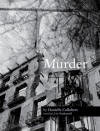Murder
Murder is hard to describe. Written in 1964 by Danielle Collobert, it has recently been translated by Nathanaël. Is Murder a series of prose poems? Vignettes strung together? A novella? And who is the story about? Who is the story for? To decode how to read Collobert’s work, examine the first line: “It’s strange this encounter with the internal eye, behind the keyhole, that sees, and finds the external eye, caught in flagrante delicto of vision, curiosity, uncertainty.” Collobert reveals the interior worlds of people through their external motions, their external grasping at memories shared. This story is both in and outside of itself.
Murder is hard to describe. Written in 1964 by Danielle Collobert, it has recently been translated by Nathanaël. Is Murder a series of prose poems? Vignettes strung together? A novella? And who is the story about? Who is the story for? To decode how to read Collobert’s work, examine the first line: “It’s strange this encounter with the internal eye, behind the keyhole, that sees, and finds the external eye, caught in flagrante delicto of vision, curiosity, uncertainty.” Collobert reveals the interior worlds of people through their external motions, their external grasping at memories shared. This story is both in and outside of itself.
Further down, the narrative ‘I’ appears: “. . . this eye, I say, dazzled by the sun that comes at my back, onto my back, into me, through my shoulders, heated like steel, has the power, or better, the strength to divine things.” Collobert is a diviner, of sorts, trying to make sense of a future that is haunted by its past and exhausted with its presence. The ‘I’ cascades over the sentences, pulls and tugs at the stories, disappears to remerge, to marry with the ‘we.’ “How did we get here?” she writes.
This post-World War II prose piece examines a world trying to navigate its way through its daily isolation. The characters of these pieces—always nameless and almost indistinguishable from one another—sift through memories of a time before war, but resign themselves to the cycle of fear and drudgery that always brings them back to the same point, to the darkness that is their present world. The ‘I’ and the ‘we’ chart the movements of these people—of the old woman in the café, of the men chiseling stone in the quarries, of the weary-faced soldiers, and of the ‘he’ behind the keyhole whom the ‘I’ has decided to kill. “We will kill him in a thousand ways. I’m well versed in murder. I invent several every day.”
When Collobert’s world is not remembering, it is striving to move forward. Often, her characters are immobile; they are caught pausing in their routine and exchanging gazes. Inside they feel isolated; outside they are all interchangeable in their pain, their search for the end. “Every day,” she writes, “I take the form of a departure.” And yet, there is a strange unity among these people. They are connected, ironically, by their solitude.
Collobert’s language is poetry, charged with metaphor and laced with melancholy. There is the “memory of a beautiful exhaustion” and the narrator (who may be us, the writer, them) declaring, “I have an internal sea.” This internal sea of emotion is somehow caught in the pages, wrangled by Collobert’s expertise with language.
Murder is a book that you can revisit in pieces. You could open it up to the man who paints monsters and try to isolate his experience, his imminent assassination. But in doing so, you’d unlock the ‘we,’ and feel the need to traverse the other pages, to explore the meaning in this man’s death compared to all of the death and memories of death that the characters are burdened with. If Murder is Collobert’s response to the aftermath of war, then it is a reminder that the war does not end when the white flag is raised, but that it rages on, in the internal crevices of the people remaining.





